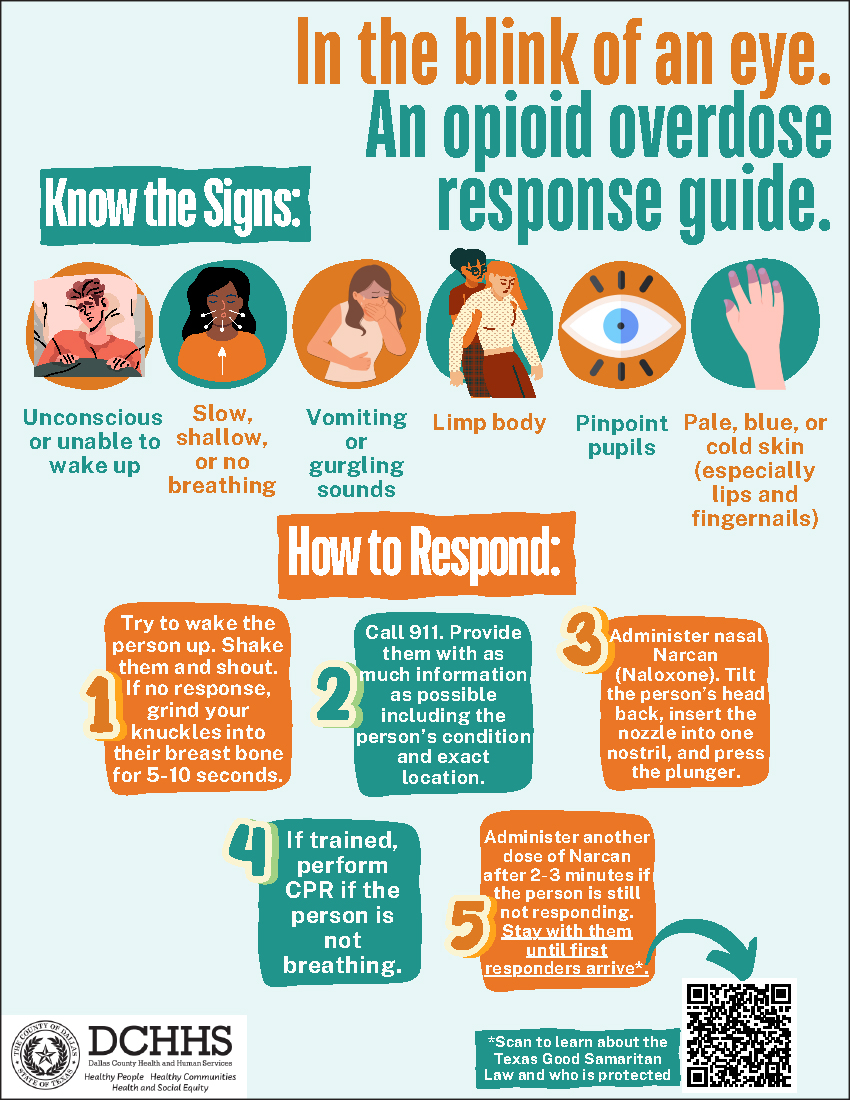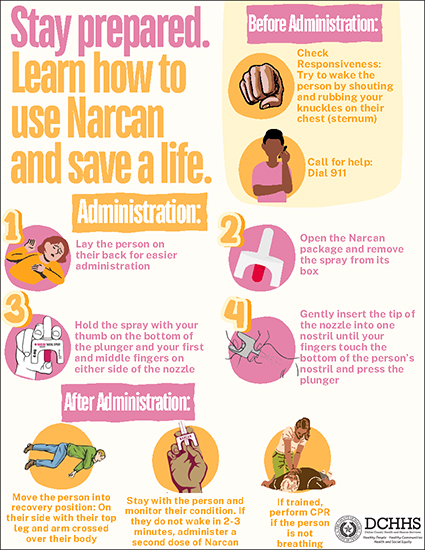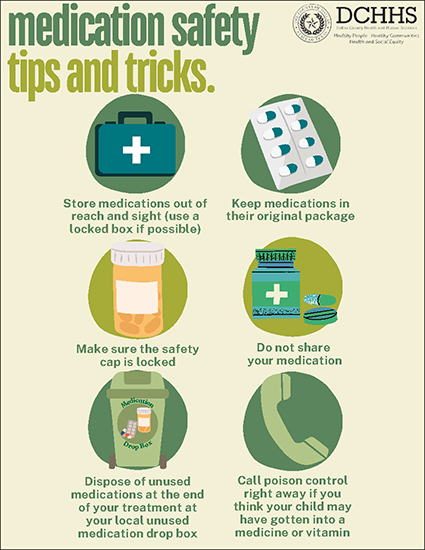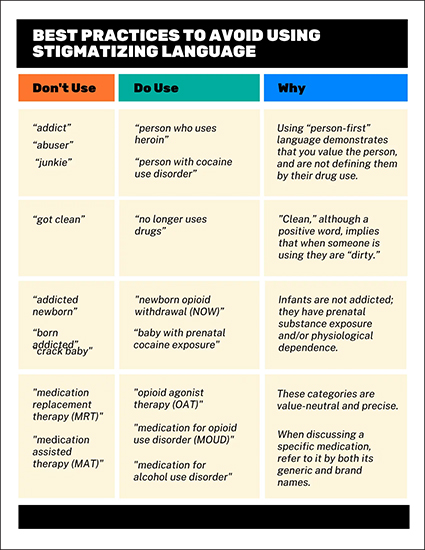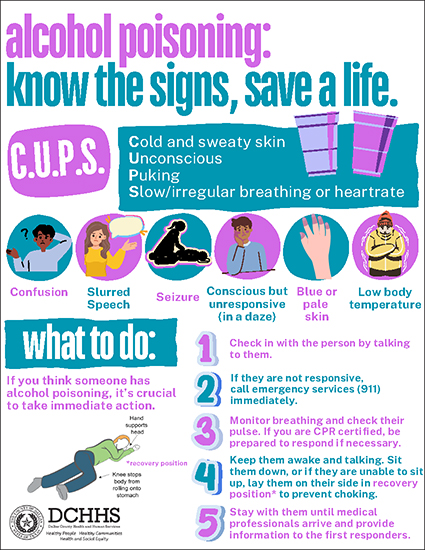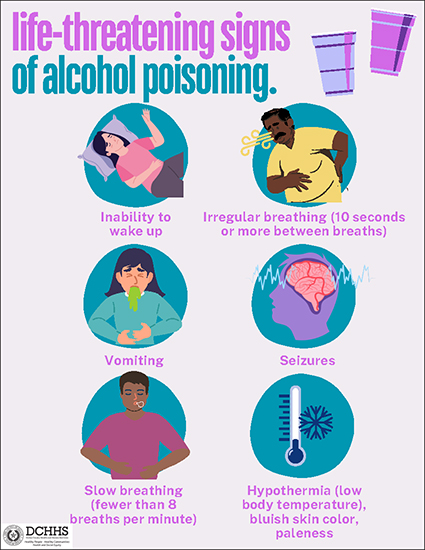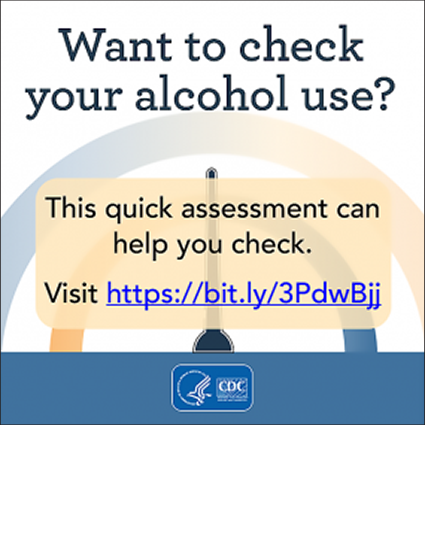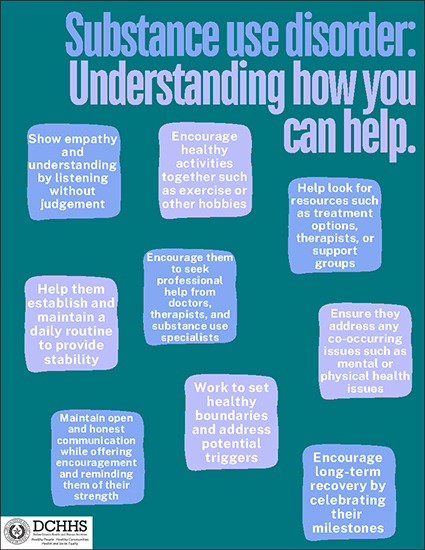Alcohol and Substance Use Prevention
Learn More (Educational Resources)
Dallas County Health and Human Services - 2377 N. Stemmons Freeway, Dallas, TX 75207
Telephone: 214-819-2000
Education, awareness, and recognizing the signs of substance use disorder can save someone’s life. Be supportive to those in your life. If you think you or someone you know needs help, talk to a healthcare professional, family members, and friends. Everyone can play a role in their recovery.
 |  |
Recognizing the signs of opioid overdose can save a life. Here are some signs to watch out for:
- Small, constricted “pinpoint pupils”
- Falling asleep or losing consciousness
- Slow, weak, or no breathing
- Choking or gurgling sounds
- Limp body
- Cold and/or clammy skin
- Discolored skin (especially in lips and nails)
- Breathing/heartbeat slows or stops
It may be hard to decide if someone is experiencing an overdose. If you aren’t sure, treat it like an overdose – you could save their life.
- Call 911 immediately.*
- Administer naloxone, if available.
- Try to keep the person awake and breathing.
- Begin rescue breathing or CPR
- Lay the person on their side to prevent choking.
- Stay with the person until emergency assistance arrives.
*Good Samaritan Law / Overdose Bystander Law
HB 1694 (also known as The Jessica Sosa Act) establishes a defense to prosecution in certain cases for people who call 911 for a possible overdose. This defense is not available for people who have previous convictions under certain drug laws, people who have already used the defense in the past and people who have called 911 for a possible overdose in the last 18 months. It becomes effective September 1, 2021, and it applies to any event on or after this date. This law does not provide full immunity from liability. So, to create clarity, we are referring to it as the Overdose Bystander Law.
Substance use disorder can impact anyone. Sometimes, people tend to hide their struggles from others, no matter how close you may be. Understanding the risk factors is important to be able to prevent substance use and intervene to get them the help they need.
|
|
|
It can be hard to identify a substance use disorder sometimes because people can have a wide degree of functioning and often can hide their alcohol or drug use. Symptoms of substance use disorders may include the following:
Behavioral Changes:
|
|
|
Physical Changes:
|
|
|
Social Changes:
|
|
It is important to understand the risk factors involved in overdose and take steps to mitigate these risks.
Click the titles below to learn more.
- Never take larger amounts or more often than prescribed
- Let your doctor know about any side effects or concerns you may have with using opioids
- Do not share or sell your prescription opioids
- Avoid taking opioids with alcohol and other substances or medications. The following cause drowsiness when combined:
- Benzodiazepines (Xanax and Valium)
- Muscle relaxants (Soma or Flexeril)
- Sleep aids (Ambien or Lunesta)
- Other prescription opioids
Protect your children/grandchildren:
 |
- Around 35,000 children every year end up in emergency rooms because they got into medicines while an adult wasn’t looking. These emergency room visits can be prevented by putting every medicine up and away, out of children’s reach and sight.
- The Substance Abuse and Mental Health Services Administration (SAMHSA) recommends that children never be told that medication is candy to persuade them to take it. This could result in them seeking out your medication.
5 Tips for Safely Storing Medications at Home:
- Put medicines up and away, out of children’s reach and sight. They commonly put things in their mouths. If you turn your back, even for less than a minute, they can get into things that may hurt them.
- Put medicines away every time. This includes vitamins you use every day.
- Make sure the safety cap is locked. Twist the top until you hear the click or cannot twist anymore.
- Tell your guests about medicine safety. Ask them to keep their purses, bags, or coats that have medicine in them up and away.
- Be prepared in case of an emergency. Call poison control right away if you think your child may have gotten into a medicine or vitamin, or even if you are not completely sure.
- Poison control center at Parkland: 1 (800) 222-1222
Protect your family and guests:
- Consider your personal risk for overdose. Are you taking a prescription medication as it was prescribed by your practitioner? Are you receiving long-term pain management? Are you obtaining and using illicit opioids?
4 Tips for Safely Storing Opioids at Home:
- Store prescription medications/opioids in a secure place, out of reach/sight from others (including children, family, friends, and visitors). If you have a locked box in your home, this is the best option to keep them out of reach.
- Keep opioids in their original package.
- Do not share your medication.
- Dispose of unused prescription medications/opioids at the end of your treatment at a medicine take-back program or at your local unused medication drop box. Dallas County has over 60+ options for you to drop off your unused medications.
Unused medication drop boxes are secure, designated locations where individuals can safely dispose of their unwanted or expired medications. These drop boxes help prevent substance misuse, protect the environment, and reduce the risk of accidental poisoning.
Unused Medication Drop Boxes Map
Using this map is simple. To find a specific unused medication drop box location, simply navigate to the map and look for the colored dots which indicate different sites. Hover over any dot to see detailed information, including the location name and address. This interactive feature helps you quickly identify and access resources in your area.
CVS
- Accepts: prescription medications, over-the-counter medications, liquid medication bottles. Not accepted: illegal (schedule 1) drugs, needles/syringes/sharp containers, aerosol cans or inhalers, chemicals, mercury-containing devices
- https://www.cvs.com/store-locator/cvs-pharmacy-locations/medication-disposal/Texas/Dallas
Walgreens
- Accepts: prescription medications, ointments and patches, OTC medications, ointments, lotions and liquids, pet medications, vitamins, aerosol cans, inhalers
- https://www.walgreens.com/storelocator/rx-disposal/fort-worth-tx
National Association of Boards of Pharmacy (NABP)
Dallas Area Drug Prevention Partnership (2 take back days in April and October)
Defend Your Drains North Texas:
You cannot put unused medications down your drain because they will go through the sewer system and into our lakes, streams, and rivers. Our wastewater treatment systems are not designed/equipped to remove medications from wastewater.
Youth may misuse prescription opioids for various reasons including curiosity, peer pressure, and a desire for social acceptance. They may also resort to substances to cope with feelings of depression, anger, stress, anxiety, or other emotional concerns. Having a conversation about the risks of opioid use could save a life.
 |  |
Tips for keeping your teen safe:
- Check in frequently
- Choose informal times to talk – in the car or during dinner
- Be clear about your expectations and consequences regarding opioids and drug use
- Cover topics such as:
- Which drugs are out there
- The dangers of substance use
- Identify risky situations and come up with an “exit plan” if they are in a situation where people are using drugs or encouraging them to use drugs
- How to avoid peer pressure
- Stay up to date on modern language:
Stigma surrounding substance use refers to negative attitudes, beliefs, and stereotypes that society holds towards individuals who use drugs or alcohol. This stigma often leads to discrimination and social exclusion of people who use substances, as well as barriers to accessing healthcare, employment, housing, and other essential services.
Click the links below to learn more about common misconceptions/stereotypes and ways to prevent the stigma.
Common misconceptions and stereotypes contributing to this stigma include:
Substance use is often viewed as a moral failing or lack of willpower, rather than being recognized as a complex issue with biological, psychological, and environmental factors.
There is a tendency to criminalize substance use and to view individuals who use drugs as criminals rather than people with health needs.
People who use substances are often blamed for their condition and subjected to shame and guilt, which can hinder their ability to seek help and support.
There is a perception that individuals who use substances are dangerous or unpredictable, which contributes to fear and discrimination against them.
Many people have limited knowledge about substance use disorders and may hold misconceptions about treatment options and recovery, resulting in increased stigma.
Here are ways you can prevent stigma:
Stigma often is a result of misinformation and a lack of understanding. Educate yourself and others about substance use disorders, including their causes, effects, and treatments. Encourage open conversation and provide correct information to dispel myths and misconceptions.
Use person-first language that emphasizes the individual rather than their condition. Instead of labeling someone as an “addict” or a “junkie”, use phrases like “person with a substance use disorder”. This helps to humanize individuals and reduce the stigma associated with their condition
Recognize that substance use disorders are complex conditions influenced by many factors. Avoid making assumptions or passing judgement on individuals struggling with substance use. Instead, approach them with empathy, compassion, and a willingness to understand their experiences.
Challenge stereotypes and misconceptions surrounding substance use disorders whenever you encounter them.
Encourage individuals struggling with substance use to seek help and support. Provide information about available resources, including treatment options, support groups, and counseling services. Normalize help-seeking behavior and emphasize that seeking assistance is a sign of strength, not weakness.
Be mindful of your own attitudes and behaviors toward substance use and individuals affected by it. Lead by example by demonstrating empathy, respect, and support for those struggling with substance use disorders. Your actions can influence others and contribute to creating a more compassionate and stigma-free society.
Click an image below to view a larger version.
QUICK LINKS
LOCATIONS
EMPLOYEES
-
You must be on the network to see these links.

